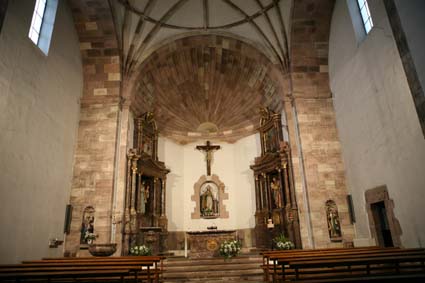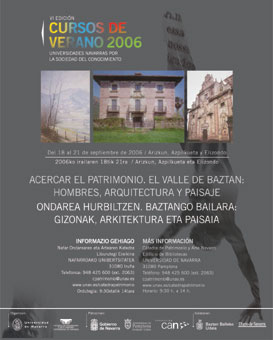BRINGING HERITAGE CLOSER. THE BAZTAN VALLEY: MEN, ARCHITECTURE AND LANDSCAPE
September 18, 2006
Ziga, Lekaroz and Gartzain: the Renaissance churches of Baztania
Dr. Mª Josefa Tarifa Castilla. Chair of Navarrese Heritage and Art.

Parish Church of San Martín. Gartzain
position The second lecture of the summer course was given by Dr. María Josefa Tarifa Castilla, who studied three churches in Baztania built in the 16th century at agreement according to Renaissance dictates: Ziga, Lekaroz and Gartzain.
The first part of his intervention was dedicated to the study of the plan, elevations, covering and exterior Structures of these temples, since they follow a similar architectural patron saint , with Latin cross planimetry, interior elevations of great architectural sobriety and high choir at the foot. On the exterior they have a processional, a typical structure of the northern Navarrese area , consisting of a porch that runs parallel to both sides of the nave from the Wayside Cross to the foot, composed of semicircular arches resting on stone pillars.
The roof system employee stands out above all, a stone shell in the space of the chancel, a characteristic that the rest of the temples of Baztan do not have and that only a few other churches in Navarra have, a singularity that makes them participants in the assimilation of Renaissance forms in their Mannerist phase. The realization of this subject of vaulting demanded a high knowledge in stereotomy, that is to say, the necessary technique in the cut of the stones that allow its application in the construction, as it gathers the Book of traças of cuts of stones, work of Alonso de Vandelvira, in one of whose leaves explains the way of undertaking the covering of concha avenerada. For its part, the central space of the Wayside Cross is covered with a vault of terceletes to which are superimposed, in the case of Ziga and Gartzain concentric circles, while in Lekaroz the vault of ribbed terceletes is enriched by a four-pointed cross, around whose central core topic a circle is inscribed.
He then focused his interest on the individualized study of each building, explaining their construction process and their architectural analysis. Of the constructive history of the parish church of Ziga, he highlighted two important construction phases, the one undertaken in the second half of the 16th century by Pedro and Martín de Oiz -from agreement to the traces given by the overseer of works of the Pamplona bishopric Juan de Villarreal-, and Martín and Juan de Urrutia, and the current appearance of the church was configured in 1783 with the addition of a royal access staircase and a processionary at internship by Santos Ángel de Ochandátegui's project . For his part, the parish church of Gartzain was initially commissioned to Miguel de Oiz, another member of this outstanding lineage of stonemasons from Baztan, and was completed by Juan de Garaicoechea y Oiz, a master used to working with this new subject with a Renaissance roof of galloned veneration, as he demonstrated in the parish church of Lerín. He finished his exhibition with the parish church of San Bartolomé de Lekaroz, the result of two important construction phases, the one undertaken from the 70s of the 16th century under the direction of the stonemason Pedro de Oiz, in which the building acquired its current configuration in plan and elevations as a Latin cross church, and the Baroque reform to which corresponds the barrel vault with lunettes that covers the nave.

PROGRAM
MONDAY, 18 SEPTEMBER
Place: Elizondo. Arizkunenea Cultural Centre
16.45 h: Opening and presentation of the course
17 h. Juan de Goyeneche, ahead of his time
Prof. Dr. Alfredo Floristán Imízcoz. University of Alcalá de Henares
18 h. Coffee break
18.30 h. Ziga, Lekaroz and Gartzain: the churches of the Renaissance in the Baztan area
Prof. Dr. María Josefa Tarifa Castilla. Chair of Navarrese Heritage and Art
TUESDAY, 19 SEPTEMBER
Place: Elizondo. Arizkunenea Cultural Centre
17 h. From the village to the Court
Prof. Dr. José María Imízcoz Beunza. University of the Basque Country
18 h. Coffee break
18.30 h. Palaces of Baztan
Prof. Dr. Pilar Andueza Unanua. Chair of Navarrese Heritage and Art
Then visit to the Ethnographic Museum of Baztan Jorge Oteiza, guided by Ms. Ana María Marín, member of the Friends of the Museum.
WEDNESDAY, 20TH SEPTEMBER
Place: Arizkun. Convent of the Poor Clares
17 h. Juan Bautista Iturralde and his foundations
Prof. Dr. María Concepción García Gainza. Chair of Navarrese Heritage and Art
Place: Azpilkueta. Parish
18.30h. Families and artistic promotion: Elizacoechea in Azpilkueta, the Jáuregui family in Oharriz
Prof. Dr. Ricardo Fernández Gracia. Chair of Navarrese Heritage and Art
THURSDAY, 21ST SEPTEMBER
Place: Elizondo. Arizkunenea Cultural Centre
17 h. Indian art and architecture in the Baztan Valley. The 19th and 20th centuries
Prof. Dr. Javier Azanza López. Chair of Navarrese Heritage and Art
18 h. Coffee break
18.30 h. Closing session: The Bidasoa School and landscape painting in Baztania.
Prof. Dr. Francisco Javier Zubiaur Carreño. Museum of Navarre
